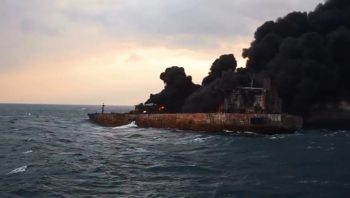
By Jite Eriabie
The three bodies that have been recovered from the Iranian ill-fated tanker Sanchi have been identified, according to Iranian Students’ News Agency (ISNA).
The three crew members are Milad Aravi, Majid Naqian and Mohammad Kavousi, the agency informed, all of Iranian nationality.
The remaining 29 seafarers of Sanchi’s 32 crew, comprised of 30 Iranians and two Bangladeshi nationals, remain unaccounted for and are feared to have died as well.
Waters polluted by the sinking of the Sanchi oil tanker could reach Japan within a month, the UK-based National Oceanography Centre (NOC) said citing an updated emergency ocean model simulation. Based on the new predictions, although pollution is most likely to reach the Japanese coast, it is also likely to affect Jeju Island, with a population of 600,000.
“However, the fate of the leaking oil is highly uncertain, as it may burn, evaporate, or mix into the surface ocean and contaminate the environment for an extended duration,” NOC said.
The latest predictions have been based on the new information about where the Sanchi oil tanker finally sank, and they differ significantly from earlier beliefs that contaminated waters would largely remain offshore, but could reach the Korean coast within three months.
Furthermore, the revised simulations find that pollution may now be entrained within the Kuroshio and Tsushima currents that run adjacent to the northern and southern coasts of southwestern Japan.
In the case of contaminated waters reaching the Kuroshio, the simulations suggest these will be transported quickly along the southern coasts of Kyushu, Shikoku and Honshu islands, potentially reaching the Greater Tokyo Area within 2 months. Pollution within the Kuroshio may then be swept into deeper oceanic waters of the North Pacific, NOC explained.
The revised simulations suggest that pollution from the spill may be distributed much further and faster than previously thought, and that larger areas of the coast may be impacted. The new simulations also shift the focus of possible impacts from South Korea to the Japanese mainland, where many more people and activities, including fisheries, may be affected.
The oil from the sunken Iranian tanker Sanchi may now cover an area of 332 square kilometers, according to China’s State Oceanic Administration.
However, accurate information about the amounts of oil spilled already and likely to be spilled in the future will be very difficult if not impossible to determine.
In order to contain the spreading oil spill from the sunken Iranian tanker, the Chinese authorities are reviewing a possibility of salvaging the wreck. Nevertheless, the plan is yet to be finalized and approved by the ship owner.
Iran, Panama, China and Hong Kong have signed an agreement on January 25 on the joint investigation of the collision between Sanchi and CF Crystal.
Work on decrypting the black boxes of both vessels is underway as well and may last up to three months.
The Sanchi was carrying 136,000 tonnes of highly-toxic natural gas condensate from Iran when it collided with CF Crystal on January 6.
Copyright Ships & Ports Ltd. Permission to use quotations from this article is granted subject to appropriate credit given to www.shipsandports.com.ng as the source.